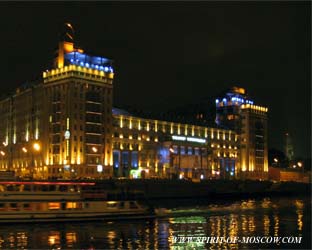 |
Just whisper the words "Dom na Naberezhnoi," or House on the Embankment , and it is enough for any Muscovite to conjure up images of walls with ears, late night arrests and disappearing Party leaders.
The mammoth structure that sits across the river from the Kremlin has become a symbol of Stalinist repression and terror, yet few remember the man who created the city's most imposing structure of the constructivist period.
The House on the Embankment was the first major work by Boris Iofan, a talented artist who was born in Odessa |
in 1891 and graduated from the St. Petersburg Academy of Fine Arts.
He then left Russia in early 1914 to explore Italy - "the mother of fine arts" - where he studied architecture and apprenticed in the studio of Armando Brasini, who would become one of the most important architects of Mussolini's Italy.
After a series of competitions, he was chosen to head a group of architects designing Stalin's famous Palace of Soviets . The ill-fated Soviet skyscraper, however, never got off the ground. Today the church that was destroyed to make way for the project, the Cathedral of Christ the Savior , has been restored on the same spot.
Built between 1928 and 1931, the House on the Embankment experienced a number of set backs while under construction. Citing fire safety regulations, a city law at the time prohibited the construction of buildings higher than seven stories. Iofan managed to circumvent this rule for his 11- story structure, only to witness the very first block he built be destroyed by fire. The incident may have been caused by the sloppy work of the builders - most of them peasants who had come in from the country with no building experience to find work during the hungry years of the late 1920s.
The 500-apartment complex was finally opened in April 1931 - becoming home to the highest-ranking members of the Soviet hierarchy. Some of the tenants included Stalin's daughter, Svetlana Alliluyeva , his KGB henchman, Lavrenty Beria, Marshal Georgy Zhukov and Alexander Alexandrov, author of the Soviet anthem.
The house itself is considered to be the grandest constructivist work ever built in Moscow . Ironically, Iofan himself could hardly be considered a constructivist. He was, rather, a pragmatic man who worked in the style of the times.
The House on the Embankment did have one thing in common with the visions of Iofan's avant-garde colleagues. The complex was virtually self-sufficient, complete with a library, a gym, a restaurant offering cooked meals to take home, a kindergarten and a Dom Kultury, or House of Culture, that was eventually converted into the massive Estrada Theater. Later a state-of-the-art dry cleaner was installed, as well as a giant movie theater, the Udarnik, seating more than 1,600. Busy bureaucrats never had to set foot outside.
Considering the living conditions of most Moscow residents in the early 1930s, the first dwellers of the House on the Embankment were living in comparative paradise. Yet their apartments, equipped with functional furniture also designed by Iofan, were far from luxurious. Looking at the preserved interiors today, it is hard to imagine that this was a building for the elite.
The paradise, however, was short-lived. Cars starting appearing at the house almost nightly to escort a new fallen Party member off to the gulag or the firing squad. Hundreds of residents fell victim to Stalin's repressions, turning the house into a kind of Titanic: Built for the high and mighty, it served, in the end, only to trap and kill them. Every other family living here in the 1930s was either executed or sent to the gulag.
Some family members of the fallen were fortunate enough to escape prosecution, but they were, nonetheless, evicted from their homes in the House on the Embankment. Some apartments had three different tenants in one year.
During World War II the building was evacuated and, under Stalin's order, mined to prevent the Germans from seizing it. Some speculate the Soviet leader was afraid the Nazis might find traces of his terror machine and use it against him.
After the war, the house lost some of its prestige. As the Party elite, among them Leonid Brezhnev, started to set their sights on newly built luxury houses along Kutuzovsky Prospekt, the House on the Embankment became home to many scientists and artists. Today, of course, the house with its spectacular Kremlin views is considered to be prestigious once again — only slightly less terrifying.
Those who visit the House on the Embankment, located at 5 Ulitsa Serafimovicha, should not miss the house museum, located in the first entryway. The museum, staffed by longtime resident Olga Trifonova, the widow of Yury Trifonov, who wrote the best-selling "House on the Embankment," is only open on Wednesdays from 5 to 8 p.m. and on Saturdays from 2 to 5 p.m.